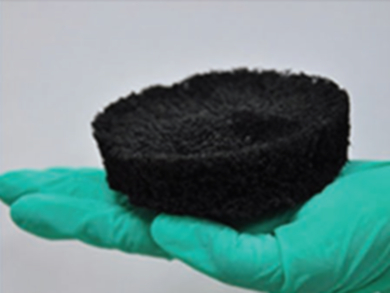Carbon nanotube (CNT) sponges combine a variety of functionalities that are interesting for applications in energy storage or catalysis. The CNT building blocks combine electrical conductivity, excellent mechanical properties, and a high surface area. Their assembly into a hierarchical 3D sponge results in good mass transfer within a macroporous network and allows shaping the material for a variety of engineering demands.
Jiaping Wang, Kaili Jiang, and colleagues, Tsinghua University, Beijing, China, exploited the strong van der Waals interaction between superaligned carbon nanotubes (SACNTs) to prepare sponges without the need of any additional binder that may compromise the CNT’s intrinsic properties. SACNTs were dispersed in water using ultrasonication, followed by freeze-drying. Depending on the concentration of SACNTs in water, sponges with porosities of 97.5–99.9 % and densities of 1–50 mg/cm–3 were obtained.
The materials have a high conductivity, can be cut into a variety of shapes, and can also be used as a template for titanium dioxide. The researchers point out the ease of preparation and the possibility to adjust porosity and density of the materials. Furthermore, they see great promise in transferring the hierarchical structure onto many other materials such as metals and metal oxides using templating methods.
- Self-assembly of 3D Carbon Nanotube Sponges: A Simple and Controllable Way to Build Macroscopic and Ultralight Porous Architectures,
Shu Luo, Yufeng Luo, Hengcai Wu, Mengya Li, Lingjia Yan, Kaili Jiang, Liang Liu, Qunqing Li, Shoushan Fan, Jiaping Wang,
Adv. Mater. 2016.
DOI: 10.1002/adma.201603549




